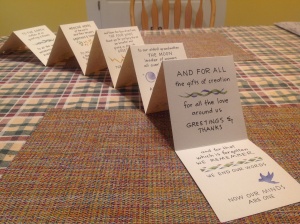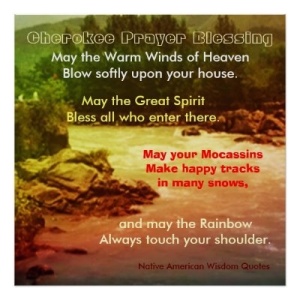At my request, the chatty group of teachers attending my presentation at the Long Island Writing Project (LIWP) on Saturday, The Power of Teaching Poetry to ENL (English as a New Language) Students, suddenly became quiet. It was a “make or break” moment. I explained that we would be reciting together a Native American prayer/poem to establish a sense of community and to honor the origins of poetry as a spoken-word practice. This prayer/poem was written on an accordion card sent to me by a dear friend from California. I then asked the participants to stand and to join in the reading.
I then started playing a CD of Native American flute music: The Canyon Trilogy, by Carlos Nakai. The lovely, soft sounds of the flute echoing against the walls of the Grand Canyone floated over and around us filling the room and our hearts as we began our reading. I began reciting the first verse, then passed the prayer/poem on to the next person, who passed it on to the next and so on until we had completed all twelve verses, ending with “Now our minds are one.” Then everyone sat down and we began our discussion.
This was a pivotal moment for me. I had thought long and hard about how I would introduce this workshop, but I kept coming back to wanting to perform this prayer/poem with the participants. I had every moment of self-doubt you can think of…they’ll think this is really corny; they’re going to be annoyed, and other troubling thoughts. But risk-taker that I am, I decided to go ahead with my plan. I am so glad I did because so much of the success of a topic depends on how it is introduced. The spell was cast.
The next two hours flew by. I explained the gist of my presentation: that poetry, which is often relegated to one month a year in the elementary classroom and an occasional appearance in the upper grades ought to, instead, be embedded in the curriculum during the entire school year for two reasons. First, when introduced in the right way, poetry is much loved by students of all ages. Second, poetry provides a new lens through which students can see the curriculum and serves as a great entry point into any topic in the curriculum.
We talked about an article I read aloud from the New York Times that discussed the paucity of vocabulary that many ENL students bring with them when they enter the American public school system at age 5 (nearly a 32 million word deficit by some estimates), and how that deficit affects their academic performance from day one until they graduate. We talked about another article from “O” magazine that declared how poetry “is not a test.” How deadly it is to ask the students, “So what does this poem mean?” instead of “Let’s talk about what we enjoyed or noticed about this poem.”
We talked about how students can learn from poetry how to be more playful with language; how they can create similes and metaphors with the proper scaffolding without even realizing they are doing so; how many ENL students have much more success with non-rhyming poetry because they do not have the command of the language nor the verbal agility they need to create rhymes in the earlier stages of their second language development.
We talked and talked and talked. I had lots of examples of poetry anthologies from my students to show as models for what can be accomplished by ENL students including cinquains, haiku, acrostics, concrete (shape) poems, found poems and lots of free verse. I showed the participants how they could use a very effective 3:2:1 graphic organizer to help their ENL students organize their thoughts into the gist of a poem…
…and then how to teach them to arrange their words into poetry.
And then the workshop was over. We had run out of time. I probably could have gone on for at least another hour, but I’m not sure my participants could have absorbed much more at that point. It was time to ask them to reflect write a reflection of what they had learned and would take away with them.
Next they shared their written responses. My heart swelled as I heard comments about how they had always thought poetry was so daunting and probably too difficult for their students; how they had only taught “to the test” when they addressed poetry as more of a necessity than a pleasure; how they had never thought of using poetry throughout the curriculum and best of all, how they really enjoyed the way I began the session with the recitation of the Native American poem as a way to immerse the students in the sensory experience of poetry. They were excited about rethinking the role of poetry in their curriculum and how to include it in their daily lesson planning.
My heart was full. After a month of two of perseverating about how to structure this workshop, whether or not to include the prayer poem, how to cover such densely layered information in such a short time, I knew I had been successful. These teachers were full of enthusiasm for poetry as a genre that is accessible to all students when introduced in a supportive, thoughtful and experiential way.
Mission accomplished. Nearly two years after my retirement from teaching and one year as a cancer survivor, I was back in the game and loving it! Thank you to the staff of Two Writing Teachers and all the dedicated Slicers and my mentors at the LIWP for supporting me as a writer this past year and breathing new life into me as a teacher. Long live poetry!






